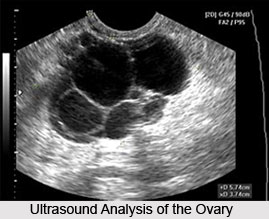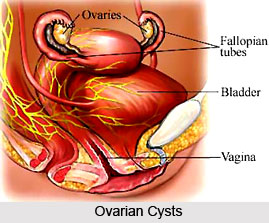 Symptoms of ovarian tumours and cysts are never noticed and they grow continually without the individual ever realizing that they are there. When a cyst causes symptoms, pain in the belly or pelvis is by far the most common one. The pain can be caused from rupture of the cyst, bleeding into the cyst, rapid growth and stretching or twisting of the cyst around its blood supply (known as torsion).
Symptoms of ovarian tumours and cysts are never noticed and they grow continually without the individual ever realizing that they are there. When a cyst causes symptoms, pain in the belly or pelvis is by far the most common one. The pain can be caused from rupture of the cyst, bleeding into the cyst, rapid growth and stretching or twisting of the cyst around its blood supply (known as torsion).
A health care practitioner may notice ovarian cysts during a bimanual examination of the pelvis. If a cyst is suspected based upon the symptoms of physical examination, imaging processes are used. Most cysts are diagnosed by ultrasound, which is the finest imaging technique for detecting ovarian cysts. Ultrasound is an imaging technique that uses sound waves to produce an image of structures within the body. Ultrasound imaging is painless and causes no harm to the woman. Cysts can also be detected with other imaging methods, such as CT scan or MRI scan (magnetic resonance imaging).
If a woman is in her 40`s, or younger, and has regular menstrual periods, most ovarian sacs are "functioning ovarian cysts," which are not really abnormal. Examples include follicular cysts and corpus luteum cysts. These actions are related to the process of ovulation that happens with the menstrual cycle. They usually fade away on their own during a future menstrual cycle. Therefore, especially in women in their age group of 20`s and 30`s, these cysts are noticed for a few menstrual cycles to confirm that they disappear.

Oral contraceptives work in part by preventing ovulation; physicians do not generally expect women who are taking oral contraceptives to have common "functioning ovarian cysts." Thus, women who develop ovarian cysts while taking oral contraceptives are often advised against simple observation; rather, they may receive closer monitoring with pelvic ultrasound or, less commonly, surgical analysis of the ovary. Other symptoms are helpful to evaluate ovarian cysts (besides the woman`s age, or whether she is taking oral contraceptives). A cyst that looks like it is just one simple sac of fluid on the ultrasound is often to be gentle than a cyst with solid tissue in it. So the ultrasound appearance also plays a role in determining the level of doubt regarding a serious ovarian growth.
Ovarian cancer is however rare in women younger than age 40. After age 40, an ovarian cyst often has a higher chance of being cancerous than before age 40, although most ovarian cysts are gentle and soft even after age 40. CA-125 blood testing can be used as a method to test the ovarian cancer, but it does not always represent cancer when it is abnormal. First, many initial conditions in women of childbearing age can cause the CA-125 level to be elevated, so CA-125 is not a specific test, especially in younger women. Pelvic infections, uterine fibroids, pregnancy, benevolent (hemorrhagic) ovarian cysts, and liver disease are all conditions that may elevate blood CA-125 levels in the absence of ovarian cancer. Even if the woman has an ovarian cancer, not all ovarian cancers will cause the CA-125 level to be elevated. Furthermore, CA-125 levels can be abnormally high in women with breast, lung, and pancreatic cancer. Symptoms of ovarian tumours and cysts should not be overlooked and proper treatment should be done immediately.




